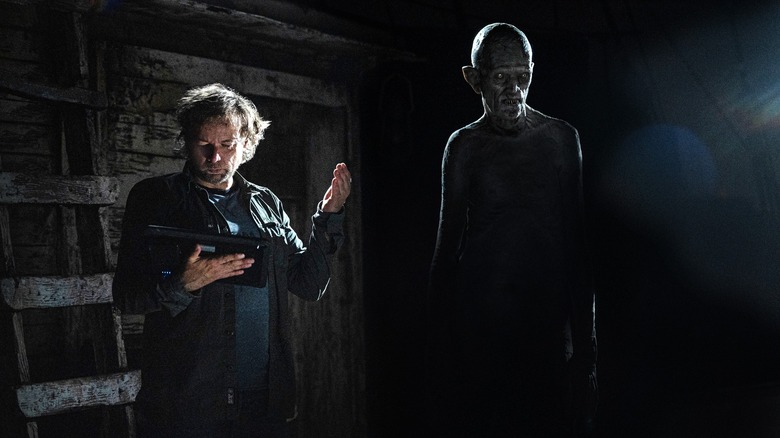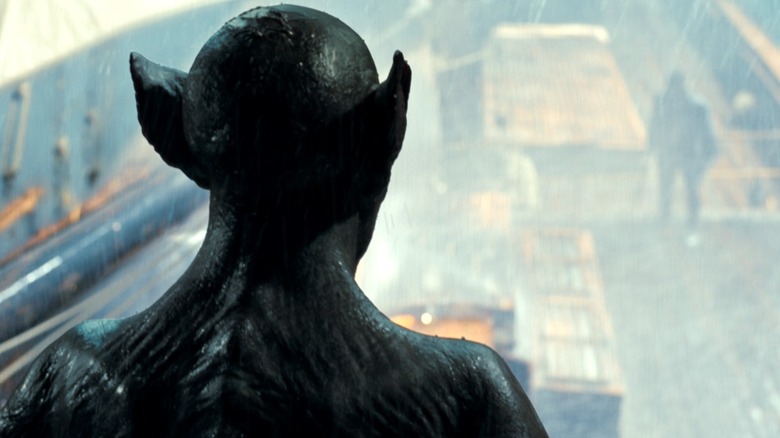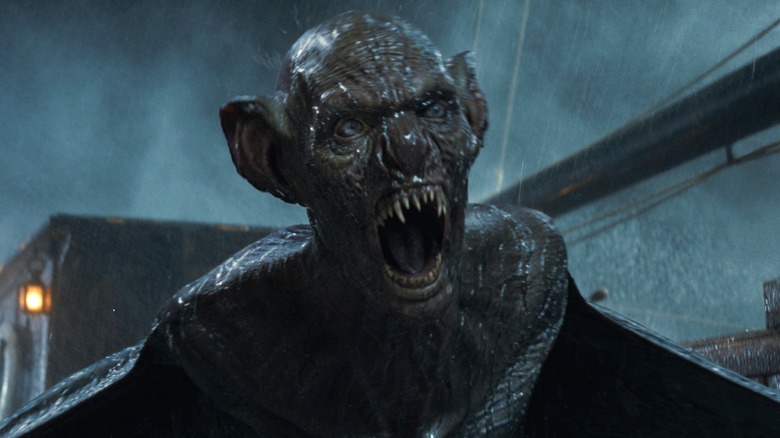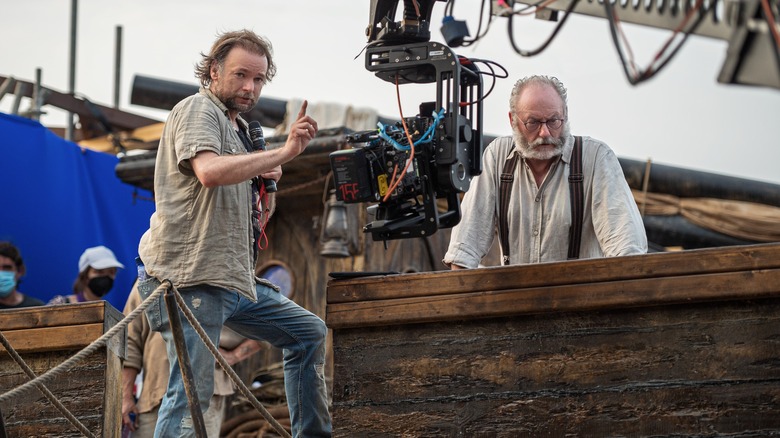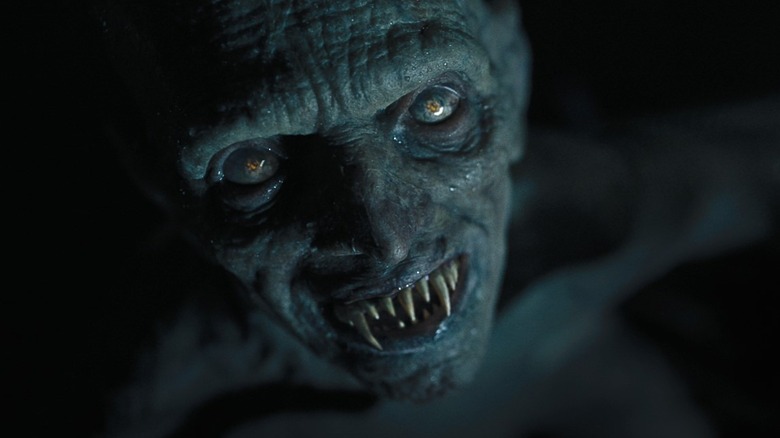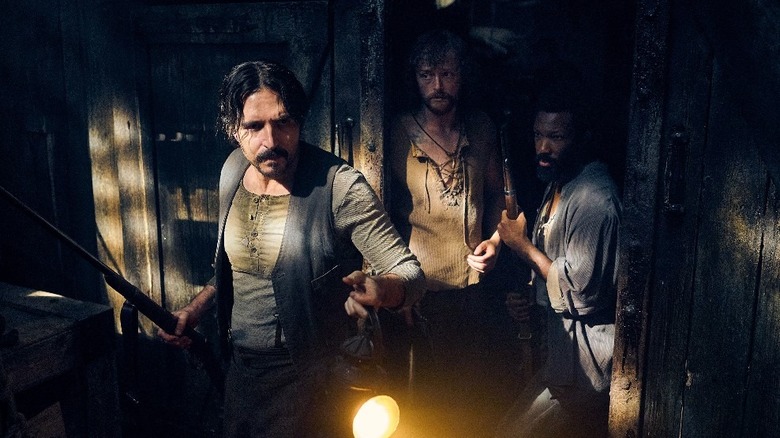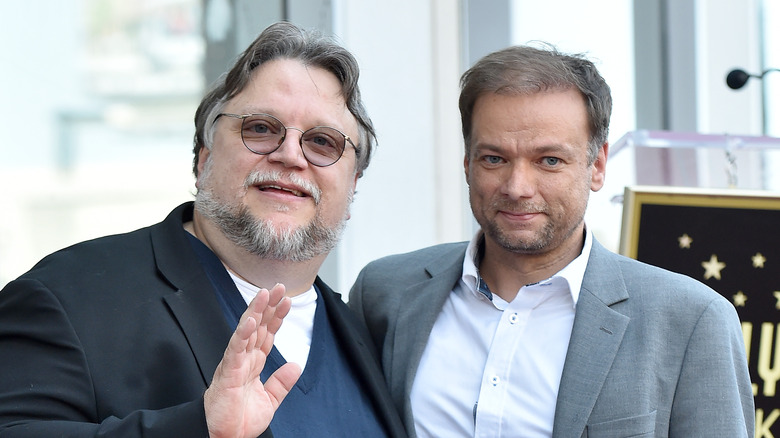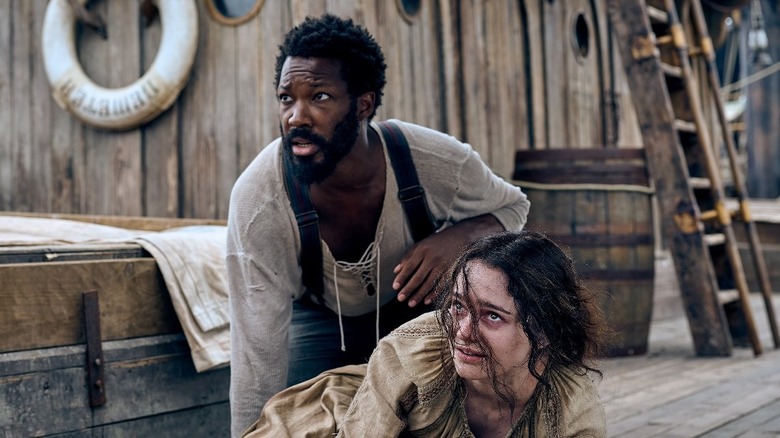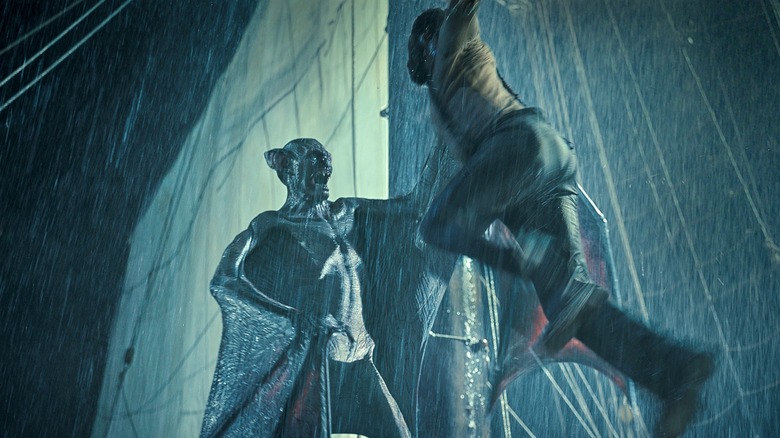The Last Voyage Of The Demeter's André Øvredal Explains Why This Dracula Tale Is Unique - Exclusive Interview
Bram Stoker's legendary creation Dracula is back on the big screen and appears in a much different light — make that night — in "The Last Voyage of the Demeter," director André Øvredal's inspired take on the Prince of Darkness that creatively separates itself from virtually every film tale about the bloodthirsty vampire that preceded it.
Instead of a retelling of Stoker's "Dracula" novel as a whole, "The Last Voyage of the Demeter" concentrates solely on a chapter in the book known as "The Captain's Log." The film chronicles the sheer terror Captain Eliot (Liam Cunningham) and his crew members, including his first mate Wojchek (David Dastmalchian) and the ship's doctor, Clemens (Corey Hawkins), endure on the high seas as the Demeter unknowingly transports a crate containing Count Dracula (Javier Botet) from Carpathia to London.
Øvredal is certainly no stranger to telling horror tales. The director's breakthrough film came in 2010 with "Troll Hunter," a fantasy thriller produced in his native Norway that was lauded by critics for its effective blend of horror and humor, which was presented in a mock documentary/found footage format. Then, in 2016, Øvredal made his English language film debut at the helm of the supernatural horror film "The Autopsy of Jane Doe," which starred Brian Cox and Emile Hirsch as a father and son coroner team. This was followed by 2019's "Scary Stories to Tell in the Dark," where the director collaborated with Oscar-winning filmmaker Guillermo del Toro.
In an exclusive interview with Looper, Øvredal details the unique opportunity he had making "The Last Voyage of the Demeter," including his practical approach in bringing the iconic character of Dracula to life on the big screen. In addition, Øvredal discusses with work with del Toro and the invaluable insight he took away from the collaboration with his fellow director.
Setting sail with Dracula from a different vantage point
With "The Last Voyage of the Demeter," you have this chapter from Bram Stoker's classic novel that has never been explored this in-depth and in such a creative manner. From what I understand — and this is what baffles me — this film has been in development a couple decades, maybe longer. When it came your way, you had to have been like, "Why wasn't this movie made earlier?" It's such a unique concept.
Yeah, that's a big question. They're always ... It's so hard; to get any movie from a micro budget to a huge budget is a miracle. Every movie is a miracle. The fact that it eventually ended up happening when I was on duty was this miracle. It came down to the producers and the studio agreeing that we [were] going to make this, and they happened to like me for it. I was so proud to be able to participate in a legacy of Dracula movies. All I can hope is that Dracula fans, like yourself, will embrace it as part of that legacy.
I would imagine you wouldn't be interested unless you were steeped in the material to some extent. First, were you a fan of the novel and thus excited about the prospects of exploring "The Captain's Log"?
I'm a fan of the novel. I read it many years ago, and it's a fantastic way of telling a story. It's scary, it's in-depth, it has great themes. It's a brilliant novel and yes, it's been so unexplored. This part is usually skipped over. The ones that have most of it ... weirdly enough, "Nosferatu," has quite a big section. I remember the John Badham version [of "Dracula"] from '79-ish [starring Frank Langella] had a big chunk on the ship, I believe. It's been a while since I saw it.
In a way, it's such a big endeavor in itself to create a movie on a ship that you can't do it as a singular little set piece. Even in the [Francis Ford] Coppola movie ["Bram Stoker's Dracula" from 1992], it's barely there, or they put all the effort into the rest of this journey of the story. I thought it was great [and I thought,] "We can copy and paste this whole movie inside those other movies."
Øvredal is thrilled that Botet was available to bring life to Dracula
Fans are going to be excited to find out the makeup effects that went into creating Dracula for this film, and that he's played by Javier Botet and is not a CGI creation. It must have been great comfort coming into a movie like this knowing, "I worked with this guy in 'Scary Stories to Tell in the Dark,'" and Guillermo del Toro and Andy Muschietti have worked with him. A lot of different directors know this guy has talent. Ultimately, he's not just wearing Dracula's makeup. He really brings this character to life.
Oh, absolutely. He is the character. I had to lean a lot on him because it's such a specialized thing to be able to portray characteristics and humanity and monstrosity at the same time through sometimes sheer body language, through a minimal mimicking of facial expressions that is also hidden by latex and whatever. It's a grueling experience for him on set to do all this in the middle of rain scenes, with the boat rocking and all nine yards. He's a trooper, both as an actor and as a team player, working through these endless nights of filming physically hard scenes for him to do.
The Demeter was a full-size replica of a ship, Øvredal says
Another way you made this film on a practical scale was in the way you used a real ship. Was this on a full-size vessel or at least something that mimics a full-size vessel? Believe me, André, you can feel that authenticity when you're watching the film. Fans are so discerning now and can determine what is CGI and what isn't, and it seemed like most of this stuff was done practically aboard a real ship.
There is definitely CG augmentation throughout, but we are always going to have, "It is not enough rain, it's not enough this. We've got to clean up the background. There is something above us that we need to remove," and it's always something. To be on that ship, we built the whole ship, both interior in Berlin and the exterior in Malta in that tank, and it's like 67 meters long. They told us in Malta that it's the biggest ship that's ever been in their tank, and its huge mast — the whole thing was real size. That was a fantastic world to be on when we were shooting it.
Øvredal says most Demeter's Dracula is most like Nosferatu
Let's get back to Javier Botet's interpretation of Dracula. To me, bar none, your film features the scariest version of Dracula since Francis Ford Coppola's man-bat version of Dracula in his film in 1992.
It's wonderful.
This is easily one of the scariest versions of Dracula I've ever seen. You want to have your own iteration of the character, but were you influenced by "Nosferatu" in terms of your Dracula's look? You're not going for Bela Lugosi, and to me, he looks closer to Max Schreck's version of Count Orlok.
In many ways, our Dracula is a silent movie character, as Nosferatu is, because he doesn't walk around and communicate and have dialogue with characters at all. He's not Gary Oldman, he's not Bela Lugosi, he's a creature that is on his own. He's a loner, and he's lonely out there on the sea. He's trying to survive, and I found that to be a wonderful story to tell, that we are talking about him trying to survive and a crew trying to survive him — and it becomes this natural conflict.
Look-wise, Nosferatu is so individual. His look and the design they did on him, and everything is so specific. Looking at any movie, we, weirdly enough, looked at [Nosferatu] a bit because ... that's a different era. It's a hundred years ago. It doesn't become an actual reference. It becomes more like, "Let's approach this in a similar way that they probably approached it."
Plus, you have the original source material in the description of the character from Bram Stoker's novel. That certainly had to have been a big help.
Absolutely, it is. His descriptions are different than what we are portraying, but we wanted to show this 400-year-old mass murderer and what that looks like. I found that to be a fascinating thing to portray, because I've seen every other iteration of Dracula and so many great ones, but this was an opportunity to do something different.
Øvredal needed to cast actors who could take control of their actions aboard the Demeter
The human ensemble is perfect in this film. How did you arrive at putting the cast together? You have David Dastmalchian, Liam Cunningham, Corey Hawkins, and so many different wonderful actors in this piece, because they are just as responsible for creating the tension in this film as Javier Botet's Dracula is.
When you're doing a movie with so many characters inter-playing constantly, you need actors who take control of their own characters, that own their characters and can live and breathe them in a way on screen where they naturally create relationships with each other based on who they are. My job is, initially, to find those people who can do that naturally, who can be opposing naturally.
I was also lucky enough to have a studio and producers who were in on the idea that, "We don't need big stars, we don't need Tom Cruise to greenlight this movie. Let's go for actors we love and who can portray the character in the best possible way, like real character actors," and then we could cast the movie the way we wanted to.
As a big fan of the horror genre, dating back to the Universal Monster movies with Dracula and Frankenstein, if you can mine another chapter from a famous monster novel, what would it be? Mary Shelley's "Frankenstein" would probably one that immediately comes to mind. Have you given thought to that?
Not specific chapters or period, but "Jekyll and Hyde" is an intriguing story that feels like it could be very psychological rather than potion-based and it has potential to be something fantastic.
Øvredal says working with del Toro changed his sensibilities as a director
I mentioned Guillermo del Toro earlier, and I caught his name at the end of the credits where you thanked him. Since you collaborated with him on "Scary Stories to Tell in the Dark," did you consult Guillermo at all during the filming or show him various cuts of the film to get his thoughts? After all, Guillermo's a big monster fan as well.
We talked about it at the very beginning, but then he went off and made his own two movies while I was making this, "Nightmare Alley" and "Pinocchio." I don't think anybody's seen much of him the last couple of years. I haven't shown him the movie yet, but I'm hopefully about to. I'm curious to hear what he thinks.
What do you think you learned from working with Guillermo on "Scary Stories to Tell in the Dark"? I thought the movie was perfect. It brought together a couple great filmmaking minds and I would imagine you emerge from a situation like that somewhat of a changed filmmaker.
I learned so much from him, from the precis of storytelling, the meaning of story. His ability to take a step back and see what the movie is from a bird's perspective, what is this movie supposed to be, and then jump down into the details and nitty gritty, machinations of moments to help portray what a grand thing is supposed to be was astounding to be experiencing.
[Also, he had] his eye on visuals and his eye on the creature design, because he was there a lot through the design of the creatures and helped me with that. That was a masterclass in how to think and how to portray these monsters. I got his way of collaborating with people and his balance between being forceful, as a director needs to be, but gentle in the way that inspires, was something to behold in a way.
Do you think you took any of the masterclass with Guillermo and somehow implemented it in "The Last Voyage of the Demeter"?
I would imagine there is parts of that ... you're making another movie and it's all ... but you are who you are in these last two years, whoever came out of that movie. I can't tell now. Hopefully, in 10 years, I can tell.
Øvredal loves stop-motion, but will leave the features up to other directors
Guillermo del Toro obviously has had the success with "Pinocchio" and loves stop-motion animation. In the back of your mind, since you've seen live-action filmmakers like Guillermo, Tim Burton and Wes Anderson do stop-motion features, is that something you hope to do at some point in your career?
I started out doing that. When I was a kid, my first films were with a video camera at the cusp of, or moving from Super 8, to my first VHS-C camera. It was with stop-motion of a little troll that was running around inside a city. I still have it. It's like 2 minutes long. It would be amazing, but there are so many fantastic filmmakers filling up that space already. I don't want to run after them!
I have to know, because it seemed like maybe it was done that way, but was there any stop-motion animation in "Troll Hunter" in the creation of the trolls? That's a difficult thing to do for any film, and since you made "Troll Hunter" in the found footage format, I'm wondering if you used that technique at all.
No, not physical, but the process, at least in the computer is kind of similar. You do one frame at a time, one little movement at a time, and then you generate ... At least at the time we were doing it, we were fairly rudimentary back then in [2008 or '09], we did all that work. It was all CG. There was one minor thing that was real. The rest was full CG.
Demeter would only work as a period film, Øvredal says
I love to see monster movies like yours made in a period setting. You couldn't have made "The Last Voyage of the Demeter" in anything but a period setting because I don't think it would've worked. Did working within the period realm help you with the creation of the film?
I can't imagine it having cell phones in this story! It wouldn't be true to the novel, it wouldn't be true to anything. It would be completely revisionist and modernization, and that's great. Those can be amazing, but that's not what we were trying to do and not what was intriguing to me ... As a filmmaker, you never know what you're going to experience. You never know what movies you're going to make by 10 years down the line or one year down the line [or even if] you're you ever going to make another movie. To be able to do a period movie like this is a unique opportunity that I embraced fully.
You also used classic monster movie techniques. The way you slowly revealed what Dracula looked like was awesome, and it helped build up the suspense. Plus, you also have the use of shadows and light and sounds from what's happening off-camera.
I appreciate that. I need the world around me when I'm making a movie to resemble what I'm trying to do, in a way. I have done a short film that was almost entirely in a green-screen environment. We use green screens here every now and then, but it was to clean up backgrounds, basically, to avoid seeing stuff that was behind the actors way out there. The rest is ... real surroundings ... The ship is real and I love that, and I also need it to be able to feel safe as a filmmaker that we're on the right path of creating something that has texture and reality to it.
I don't know what you have next, but please tell me that somehow you and Guillermo are going to get back together to tell more "Scary Stories to Tell in the Dark."
I'd love to. The project still exists, so it's been ... [we're going] through a big strike.
Written by Bragi Schut Jr. and Zak Olkewicz, and also starring Aisling Franciosi and Stefan Kapičić, "The Last Voyage of the Demeter" opens in theaters Friday, August 11.
This interview has been edited for clarity.
